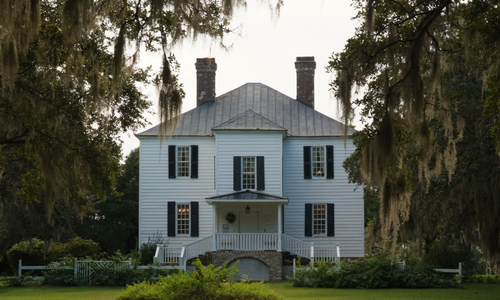
Like the seemingly bottomless swamps and salt marshes of the South Carolina Lowcountry, history runs deep on the south side of the Grand Strand. And nowhere does local history run deeper than at Hopsewee Plantation in rural Georgetown County.
Located about 12 miles south of the port city of Georgetown and just over an hour’s drive south of Long Bay Resort, Hopsewee Plantation offers a true taste of Colonial American history on the Carolina coast. Guests at Long Bay Resort can take one day out of their Myrtle Beach vacation to travel three centuries back in time for a hands-on history lesson that highlights life on a pre-Revolutionary War rice plantation.
Built in approximately 1740 on the banks of the North Santee River, Hopsewee Plantation is located on a property that once spanned more than 3,500 acres and served as one of the chief rice-producing centers in the world. Although the rice fields and slave quarters have long since been abandoned, the beautiful two-story plantation home remains operational and occupied by the current owners — the Beattie family.
The homestead was originally built and settled by the Lynch family. In fact, Declaration of Independence signer Thomas Lynch Jr. was born at Hopsewee Plantation, and the family served at the forefront of shaping South Carolina and American history until the Civil War spelled the end of an era for the South.
Once left in ruins, Hopsewee Plantation was later renovated and preserved by private owners through the decades. Although modern tools and craftsmanship were needed to revive the old homestead, much of the original architecture and furnishings still look as they did in the old days. Heart pine floors, black cypress walls and hard-carved fixtures provide an atmosphere that allows guests to feel like they've passed through a time machine as they take a tour from the stone cellar to the attic.
Dedicated to historic preservation and accuracy, Hopsewee Plantation also features two slave cabins that have been restored to their original condition. The disparity between the luxury home and the spartan conditions of the slave cabins shows the inherent inequalities of the institution of slavery and provide visitors with a firsthand reminder of how African-Americans endured generations of forced servitude, yet somehow found ways to create and preserve their own culture under difficult conditions.
For all the man-made structures on the property, perhaps the property’s top attraction is the natural beauty that surrounds the compound. Stroll the stately grounds under twisting live oaks draped in Spanish moss, through brilliant gardens featuring local wildflowers and down to the edge of the North Santee River that flows as slow as molasses. Cap it off with a visit to the River Oak Cottage Tea Room for some good country cooking, souvenir shopping or a cup of coffee while you soak in the Southern charm.
While you are on your tour of historic sites in Georgetown, be sure to check out other classic attractions like the Rice Museum, Hobcaw Barony and the historic waterfront district. On the way back home, visit the Hammocks Shops Village and South Carolina’s tiniest town hall in Pawleys Island, or Brookgreen Gardens and Huntington Beach State Park in Murrells Inlet. And once you finally return to your comfortable room at Long Bay Resort, relax in the modern luxury while you reflect on your journey through the past.

